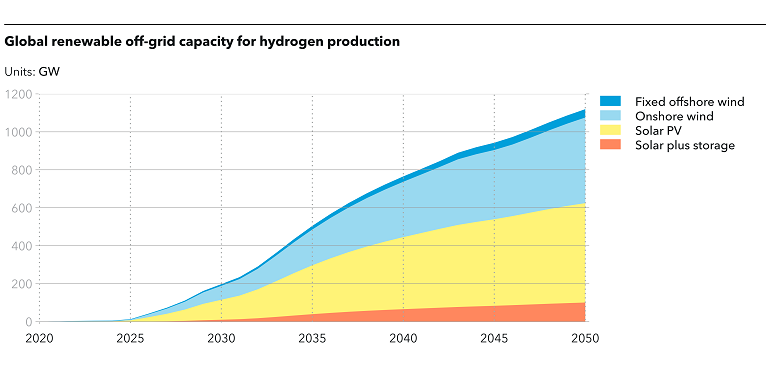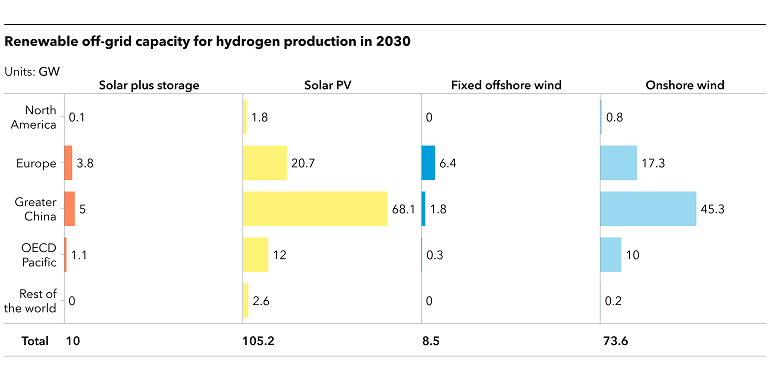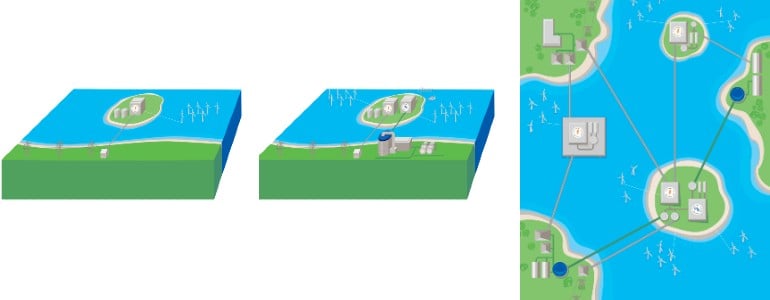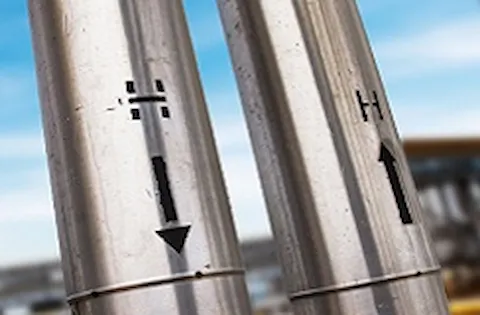Cost reductions in solar and wind power generation will enable dedicated hydrogen production to compete with grid-based and fossil-based hydrogen production in the coming decades, but this presents challenges, many of which could be overcome through energy islands.
This feature article draws DNV's picture of how energy islands could support the production of off-grid renewable electricity and the decarbonization of hard-to-abate sectors, through supporting hydrogen and other e-fuel production.
In the context of this article, we define an energy island as a hub for electricity generation from off-grid renewable sources, possibly including related production of electricity-based fuels. We want to shed more light on this highly interesting concept and our view of its development towards mid-century. We explore what energy islands could look like when integrated into an energy system striving for deep decarbonization, and we focus solely on hydrogen as an energy carrier.
Energy islands can strengthen energy security, by increasing available acreage and improving the efficiency of offshore renewable generation
The world’s first energy islands are planned for the North Sea, offshore Denmark. Plans have been in the making for some time, but the war in Ukraine has dramatically increased the focus on energy security in Europe (DNV, 2022 ), and on greater offshore renewable generation supported by energy islands as a potential solution. The context is that more than half of Europe’s energy needs are currently supplied by countries outside Europe.
The further build-out of renewables to support electrification is a pillar of Europe’s energy security, reducing dependence on imported fossil fuels – such as by switching to electric vehicles fueled by domestic electricity, from gasoline vehicles fueled by foreign fossil energy. Electricity-based fuels such as hydrogen are another pillar of a decarbonized energy system, envisaged by many countries to be produced from renewable energy in the medium to long term.
According to DNV's Energy Transition Outlook 2021, we will see more than 80% of Europe’s grid electricity coming from renewable sources by 2035, a level that is reached globally by mid-century. With most regions' electricity grids not being fully decarbonized in the next decade, it is dedicated off-grid renewable energy production that is driving green hydrogen production and its scale-up. Emitting almost no carbon emissions throughout its value chain, hydrogen produced from dedicated off-grid renewables has significant environmental benefits compared to grid-based or fossil-based hydrogen.
Onshore wind farms and utility-scale photovoltaics (PV) benefit from cost competitiveness and have promising market potential, and are therefore well suited for a hydrogen economy based on renewable energy sources. However, regions such as Europe are densely populated and have high energy demand. Space is scarce, and the availability of land for onshore wind farms and utility-scale PV poses a barrier to further renewables expansion in many countries of Europe (Diogenes et al., 2020). Offshore renewable power production is a solution to this, and energy islands can support this at scale. Today, offshore wind farms supply electricity directly to the neighboring mainland. Locating them even further away and connecting them in a hub-based system would increase available acreage and increase efficiency, allowing producers to harvest from even better wind sources and distribute the electricity to places where it’s needed most.
First electrification, then hydrogen production
The priority is to use the electricity to decarbonize sectors in which direct electrification is an option. However, due to the variability of renewable sources, excess electricity will be increasing available at certain times, and it will be beneficial to use this excess for the production of electricity-based fuels such as hydrogen.
From another perspective, demand is growing for low-emission fuels, especially from sectors that cannot viably be decarbonized through electrification. The availability of electricity-based fuels provides a promising alternative pathway to decarbonize these sectors, supported by centralized and large-scale renewable electricity production.
The concept of an energy island is the first such example of dedicated off-grid renewables being used for hydrogen production. While Europe is the frontrunner in the development of this concept, other regions are also investigating the concept, either for wind power similar to concepts developed in Europe (Tamil Nadu energy island in Gulf of Mannar) or for solar power. Some of the concepts currently being developed in Europe focus first on grid decarbonization and aim at adding hydrogen production at a later stage. Other energy island concepts will focus directly on the production of hydrogen from off-grid wind.
Energy island potential is underpinned by strong outlook for producing hydrogen from dedicated (or off-grid) renewables
One clear advantage of the energy island concept is the potential for large-scale production of almost zero carbon emissions hydrogen based on electrolysis, so-called green hydrogen. Underpinning this is the outlook for dedicated renewables vs grid-based electricity used to produce hydrogen via electrolysis, with energy islands supporting the scaling of dedicated (or off-grid) renewables for hydrogen production.
DNV forecasts that cost reductions in solar and wind power generation will enable dedicated hydrogen production to compete with grid-based and fossil-based hydrogen production in the coming decades. In 2030, we forecast that 140 GW of off-grid renewables provide 50% of world hydrogen supply (Figure 1). It is split almost evenly between solar and wind.

Source: Advanced preview of data from DNV’s Hydrogen Forecast to 2050, set to be launched in June 2022.
With hydrogen production based on grid electricity, market growth and increasing competition for green hydrogen will lead operators to reduce variable costs by running electrolysis when the electricity price is low. These hours will increase with a continued penetration of variable renewable sources, in turn increasing the number of takers of cheap electricity and complicating access to them.
Grid costs and taxes come on top of this, representing a significant portion of the operating expenditures of electrolysis. In contrast, off-grid renewable sources reduce the risk of future fluctuating electricity prices by replacing electricity costs with an upfront investment in renewable capacity.

Source: Advanced preview of data from DNV’s Hydrogen Forecast to 2050, set to be launched in June 2022.
Concept benefits from flexibility to transport energy as both electricity and molecules
Transporting renewable energy from sources of production to centers of consumption is a major challenge in the energy transition, with both environmental and economic barriers to large-scale transport. Energy islands can enable the transport of renewable energy in the form of both electricity or as gas – in this case hydrogen. Electricity can be transported and fed into the grid or can be transported to closer-to-consumption hydrogen production sites onshore. It can also be used for hydrogen production offshore on the energy island, and then transported to neighboring industrial complexes via pipelines.
Hydrogen transport in pipelines and electricity transport via electricity networks each have their advantages and drawbacks transporting decarbonized energy, but in general pipeline transport is more cost-effective for long-distance transport, if the desired end-product is hydrogen. Pipeline transport is also more space-efficient with a 48-inch pipeline replacing between five and nine overhead transmission lines (European Hydrogen Backbone, 2021). For hydrogen energy islands, it is the potential to transport energy as both electricity and molecules that is an advantage – determining the best option based on distance, infrastructure, end use and other considerations.
Environmental, legislative, infrastructure challenges need to be resolved
There is a race for space in the ocean (DNV, 2021), with fisheries and aquaculture, shipping, and tourism making greater use of offshore resources along with the energy industry, creating a need to align offshore infrastructure projects. There is also a need to balance offshore development with environmental priorities, with preserving nature set to be a key consideration when determining the location and scale of energy islands. From a total environmental perspective, however, the potential for these large-scale projects to combat climate change likely outcompetes localized environmental concerns related to animal populations, feeding areas, and noise pollution.
The construction of the islands themselves in an offshore environment will also be a challenge, due to them being exposed to steady and strong winds, waves, and deep water. This results in shorter construction windows compared to building large infrastructure projects onshore. Energy islands will also require support across the value chain, particularly from ports – which will provide the necessary infrastructure for wind farm construction, for example, as well distribute the electricity or electricity-based fuels produced.
Current legislative frameworks have not been developed with energy islands in mind. A new regulatory framework is highly needed, especially if energy islands are to serve more than one power market. On top of this comes the physical challenge to connect an energy island to several markets with different market rules, requiring a common approach for high-voltage direct-current grids (European Commission, 2020).
Potential competition between grid decarbonization and hydrogen production also presents challenges at the policy and regulatory level, with discussions ongoing in Europe for example, on whether hydrogen should be classed as green if it is produced from sources that weren’t developed solely for the purpose of producing hydrogen – that is, if hydrogen production is consuming renewable energy that could otherwise help decarbonize the grid supply.
Multiple concepts for energy islands
A multitude of energy islands concepts are developing based on the prevalence of the drivers and barriers set out above in different markets. They have different designs – including both natural islands and platforms – and different purposes. Regions such as Greater China are prioritizing employing energy islands to generate renewable power to decarbonize the grid, whereas Europe is focused on both grid decarbonization and dedicated hydrogen production.
Initially, many energy island concepts will mainly serve as electricity distribution hubs. However, there is a growing need to convert renewable-based power to molecular fuels, to supply clean energy to sectors such as industrial heating, maritime shipping, or aviation that have few alternatives to decarbonize. Accordingly, at a later stage, parts of the available renewable power from electricity focused islands may be assigned to fuel production. Alongside, other projects are being planned that will focus immediately on the provision of power-based fuels.
Another difference in concepts is where the electrolysis is planned to take place, whether onshore or offshore. The question of onshore or offshore electrolysis is not only a question of transport of molecules vs. transport of electrons. Electrolysis onshore offers the opportunity to use the excess heat arising from electrolysis in a low-temperature range that could be fed into district heating networks to heat homes while at the same time maximizing economic output of the electrolyser (Burrin et al., 2021).
The following present some of the energy island projects and setups currently under development:
Artificial island, land based – North Sea. Electricity first, then hydrogen potential
Located about 100km west of Denmark's coast, a 1,000km2 project is in development for an island and offshore wind generation with an initial capacity of around 3 GW by 2030, with an additional 7 GW of optional expansion. Project cost estimates range between €8 bn (3GW) and almost €30 bn (10GW). Considering its strategic location, the island will be in a good position to first deliver green electricity to Danish homes and later hydrogen to the European mainland and industry hubs such as Germany. It is planned for the artificial land-based island to host installations such as a data center, port, and an electrolyser. However, cost developments may lead to the electrolysis happening onshore.
Natural island, land based – Bornholm: Electricity first, then hydrogen potential
A slightly different concept involves the natural island of Bornholm off the southeastern coast of Denmark. Here the natural island is planned to act as the hub to connect about 3-5 GW of offshore wind capacity with prospects to also link the infrastructure to Sweden, Germany, and Poland. Similar to the project planned off the west coast of Denmark, the initial focus is on green electricity with a possible additional production of green fuels such as hydrogen or ammonia in the future. This project will be constructed in the 2020s and go online no later than 2030. Current cost estimates are in the area of €2bn.
Natural island, land based – Helgoland: Focus on hydrogen production
The German Island of Helgoland will serve as a hydrogen hub with connections to mainland Europe. Initially the island will be flanked with 10 GW offshore capacity by 2035, intended to be fully used for hydrogen production. A share of the produced hydrogen shall be used on Helgoland itself and in shipping.
Artificial Islands and platform – North of the Wadden Sea Islands: Focus on hydrogen production
A planned project in the Netherlands aims to have 4 GW offshore wind capacity by 2030 and 10+ GW by 2040 to be fully used for electrolysis, which equals about 0.4 million tons hydrogen in 2030 and 1 million tons in 2040. The necessary offshore wind power will be installed off the coast of the Netherlands, and initially deliver the green power to an electrolyser on the coast in Eemshaven. The setup would enable future electrolysis offshore as well, but this has not been decided yet. The project is estimated to cost €9bn, a 20% reduction compared to a distributed approach.
Conclusion: Energy islands are an important pillar to scale up renewable electricity and renewable based hydrogen production
Most current energy island concepts are at the idea stage and under development, and their final setup is likely to change. During this initial phase, strong governmental support will be needed, as will new business models until the production of hydrogen and e-fuels is a viable option and competitive with fossil alternatives.
A significant advantage of energy islands is the connectivity to different end uses and thus flexibility in providing the future solution for a decarbonized energy system, may it be through renewable electricity, low-carbon hydrogen, synthetic fuels such as electricity-based ammonia or all of the above. Whereas much of the European focus is on offshore wind connected to energy islands, the general concept might look different in other parts of the world, including solar PV or onshore wind.
In our upcoming Energy Transition Outlook report “Hydrogen Forecast to 2050”, to be launched 14 June, we present our comprehensive hydrogen forecast, including production costs and volumes, energy transport and end uses.

This illustration shows a simplified evolution of energy islands. Left image shows a first phase where the main focus is on grid decarbonization. The center image shows a second phase where grid decarbonization has mainly been achieved and surplus electricity is used for hydrogen and e-fuels production. As outlined in the article, there are projects aiming at skipping phase 1 and directly moving to phase 2. The right image shows a possible final stage where multiple energy islands are connected to multiple countries and dynamically responding to changing demands.
References
- Burrin,D. ,Roy,S. , Roskilly, A.P., Smallbone,A. (2021) A combined heat and green hydrogen (CHH) generator integrated with a heat network, Energy Conversion and Management, Volume 246
- DNV, 2021 OCEAN’S FUTURE TO 2050 - A sectoral and regional forecast of the Blue Economy, 2021
- DNV, 2021b ENERGY TRANSITION OUTLOOK 2021 - A global and regional forecast to 2050, 2021
- DNV, 2022 THE UKRAINE WAR WILL NOT DERAIL EUROPE’S ENERGY TRANSITION, 2022
- Diogenes, J., Claro, J., Rodrigues, J., Loureiro, M. (2020) Barriers to onshore wind energy implementation: A systematic review, Energy Research & Social Science, Volume 60
- European Commission, 2020 An EU Strategy to harness the potential of offshore renewable energy for a climate neutral future
- European Hydrogen Backbone, 2021 Analysing future demand, supply, and transport of hydrogen
